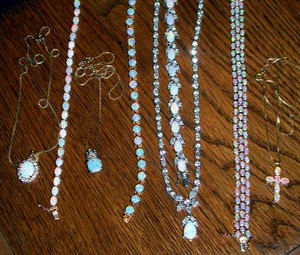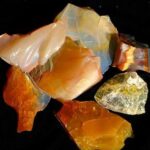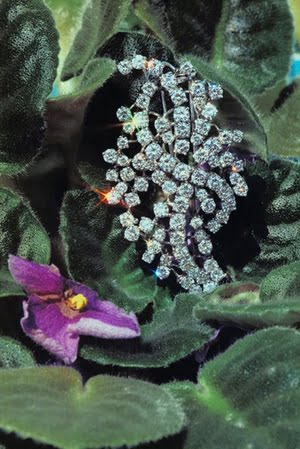Most women love jewelry and I’m no exception. In fact, I’ve collected jewelry off and on for several years. My collection actually came in very handy when my mother developed Alzheimer’s. It helped to pay off some rather expensive hospital bills.
Although I have sold a lot of my jewelry, I could not bring myself to sell either my turquoise or opal pieces. I kept the turquoise because I’m part Cherokee and I come from Oklahoma. I consider the stone a part of my heritage.
I kept my opals because they are my very favorite gemstone. I consider turquoise and opal to be two of the most beautiful opaque gemstones ever made.
Opal is an ancient stone. It dates back more than 60 million years and very likely existed in abundance during the time that dinosaurs roamed the earth. Although opals are found in many different countries, including Brazil, Czechoslovakia, Mexico, and the United States, the majority today come from Australia. It it most often found in areas where hot springs have dried up or in locations that tend to have extended dry periods.
Opal was highly praised by the ancient Romans, ranked second in value only to that of the emerald. There are also opals set into the crown jewels of France. Queen Victoria also made the stone one of her court’s favorites. Although Egyptians did not consider the stone particularly valuable, they used it in a lot of their jewelry and accessories because of its beauty.
Opal is a natural hydrated form of silica that contains between seven and ten percent water. Although opals are basically opaque, they contain a variety of colors that refract in the line. The result is referred to as the opal’s “fire.” The number and range of colors included in an opal is determined by the spacing of its silica spheres.
Until a few years ago, I was unaware that opals actually come in a variety of colors. I had only seen them in white. However, there are a variety of opals. The most common are:
Black opal has a dark background which ranges in color from blue to gray and finally black. The fire of black opals tends to skew to the color red, however, it also sparks colors of green, blue, and orange.
Black opal, in the purest form, is very rare and, therefore, quite expensive. The more colors included in the opal and the brighter the shades represented in the fire, the more expensive the stone.
Boulder opal features a totally opaque background with a thin layer of natural opal on top. It can come in various colors like yellow, pink, and blue.
Crystal opals are sometimes totally transparent and other times more translucent-like. Because it doesn’t reflect a lot of color alone, it is generally mixed with a another opal backing. This process allows the crystal opal to show its fire.
White opal is the opal with which most of us are familar. It is the most common and features a white or very pale background with refractions of light that run the gamut of the color spectrum.
The colors of an opal can change somewhat depending upon the angle of light hitting the stone or the direction from which the stone is viewed. Consequently, it can appear that an opal’s color changes as it is turned. From some angles it may look like a solid opaque stone, while at others angles it may be excessively fiery.
Opals set into jewelry may be handled several different ways. Solid opals are exactly what they sound like. They are solid pieces of opal, which are almost always cabochon cut. Solid opals are more valuable because they contain a higher concentration of actual opal.
Doublet opals are those that are, as the name suggests, doubled with another opal on the bottom. This process is excellent for opals that simply aren’t of sufficient thickness to stand-alone. Boulder opals are often perfect for this process because they come in a variety of shades and have an unusual brightness.
Although opal doublets aren’t as highly desired as regular opals, they can be extremely colorful and cost much less than the standard. This is an excellent process to be used with black opals because it can intensify the darkness of the color.
Opal triplets consist of three different layers. The bottom piece is usually a common opal that may not have as much fire as is normally desired. The second level of opal is a sliver of precious opal that has good refractive capabilities. Over the top, a thick quartz layer is placed to protect the middle opal and finish off the piece.
Opal triplets aren’t particularly popular among collectors. It does, however, have its own customer base among opal lovers. As might be expected, an opal triplet is often even less expensive than a doublet.
Inlaid opals are opals that are broken up and inserted into jewelry in a mosaic format. Black and crystal opals are more often used this way, however boulder opals have also been set in this matter. For the most part, white opals are not typically inlaid.
Fire opals are yet another form of opal. However, it bears little resemblance to the other types. Fire opal can be translucent is a translucent or semi-opaque and it is most often a sunflower yellow to a vibrant shade of orange. A few fire opals are actually a combination of both. An occasional stone even shows flashes of red.
Unlike most other opals, fire opals are almost always faceted. Slightly harder than the more traditional opal, the fire variety can be cut into fancier cuts.
Although the type of opal used has an effect on its cost, it isn’t the only factor. When all other factors are the same, then the size of the opal also comes into play. So does the degree of the opal’s fire.
Milky opals that reflect little color have less value than any other type of opal that has a great deal of fire. Even the colors that the opal reflects have an impact on the stone’s value. Refractions of red, orange, and yellow, for example, hold more value than the colors of green, blue, or violet.
Unfortunately opals aren’t as sturdy as other gemstones. They only rank five on the Mohs hardness scale.
Opals can easily crack and break. For this reason, individuals who work a lot with their hands shouldn’t wear rings that are made out of opal. Opal rings, in particular, are best used for dress occasions and not for everyday use.
Opals that are exposed to the sun, extreme cold or harsh chemicals on a regular basis will dry out quickly and lose their iridescence. Therefore, opals need to be oiled regularly. To clean an opal regularly, rub it with a soft fabric, like silk, or a facial tissue.
Opal is the birthstone for October (along with pink tourmaline). It is also the birthstone of the astrological sign of Libra (September 23 through October 22). It is the anniversary gemstone for the 18th year of marriage.
Opal has been associated with a lot of superstition over the years. In medieval times, opal was believed to have healing powers. It was recognized as the stone of confidence as well as creativity and was believed to increase mental acuity.
The Greeks thought the gemstone would endow its owner with powers of foresight, while Romans considered it the stone of purity. In some cultures, ground opal was used in potions to ward off nightmares.
Because opals can be quite expensive, they are sometimes created in the lab. There are also synthetic opals available and a wide variety of opal imitations. Some are quite good while others are poor imitations.
My mother gave me my very first opal piece; a heart shaped ring set into 14K gold. She said the heart represented her undying love for me and that she chose opal because of all its fire. She thought the the many different sparks of color represented my many qualities. I obviously cherish that piece above all others.
I own several different types and colors of opal including white, pink, and blue. I love them all but still prefer the original white best of all. There is just something about the stone that triggers feelings of hope for tomorrow.




